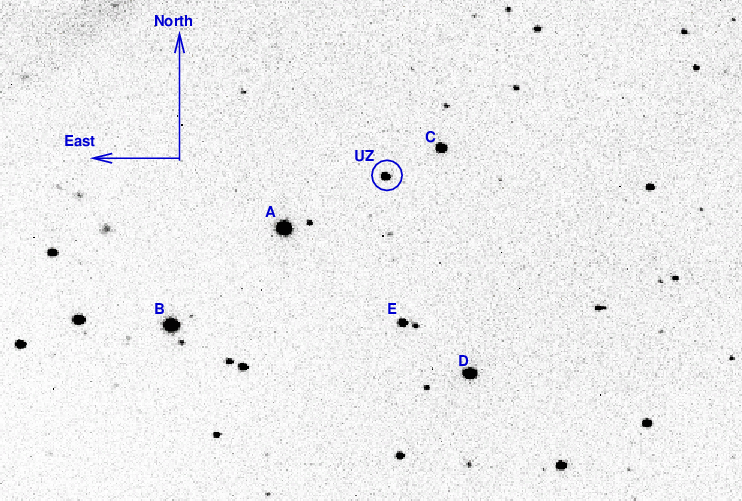
On the night of Aug 23/24, 2013, I observed UZ Boo and SN 2013ej in M74. Conditions were good -- no clouds, decent seeing. The nearly full moon was pretty close to M74, though, so it made the background very high.
The main setup was:
Notes from the night
I took a series of images of UZ Boo, using a 150-second exposure time, since UZ Boo has been faint recently. Tonight, the star was much brighter than it has been for the past few nights, at mag V = 14.5 or so.

I measured UZ Boo and many other stars in the field. Since I used a V filter, the bright stars "A", "B" and "D" were NOT saturated, and were included in the ensemble solution. I used the star "A" = UCAC4 561-055134 = AAVSO 000-BBV-651 to shift the instrumental magnitudes to the standard scale. These measurements are made with the standard V filter. and I'll shift them to match the V-band scale: 000-BBV-651 has mag V = 11.094 according to the AAVSO chart 12447AMF.
Below are light curves for UZ Boo and several of the unsaturated stars in the field. You can see that I only made three measurements.
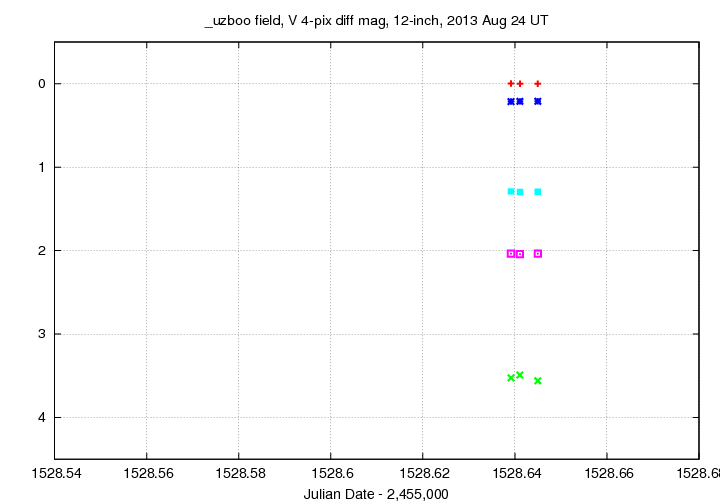
The variable star has entered a phase in its evolution in which it fades by about 2 mag, then rebrightens, then fades again, then rebrightens, etc. My measurements at the RIT Observatory catch UZ Boo at several places in this complicated evolution; tonight, it was near the top of a bright phase.
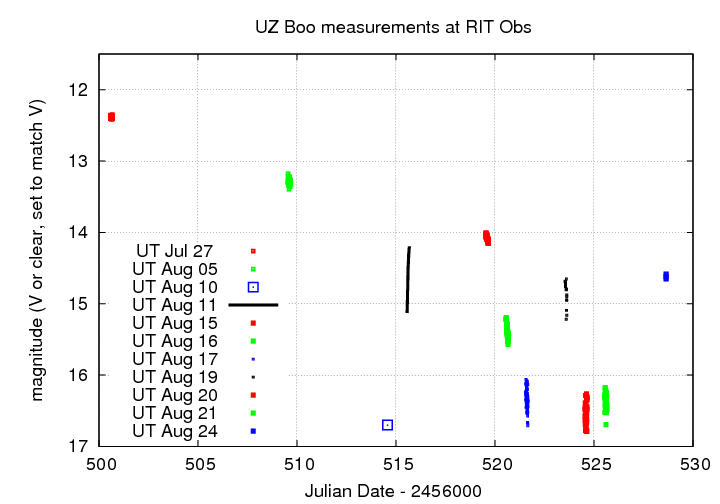
Below are the first few lines of the report I've sent to the AAVSO and VSNet.
# Measurements of UZ_Boo made at RIT Obs, Aug 24, 2013 UT, # in good but bright conditions, # by Michael Richmond, using 12-inch Meade and SBIG ST-8E CCD. # Exposures 150 seconds long, V filter. # Tabulated times are midexposure (FITS header time - half exposure length) # and accurate only to +/- 1 second (??). # 'mag' is a differential magnitude based on ensemble photometry # using a circular aperture of radius 7.4 arcseconds. # which has been shifted so UCAC4 561-055134 has mag=11.094 # which is its V-band magnitude according to AAVSO. # # UT_day JD HJD mag uncert Aug24.13916 2456528.63916 2456528.63675 14.620 0.022 Aug24.14110 2456528.64110 2456528.63869 14.585 0.020 Aug24.14498 2456528.64498 2456528.64257 14.654 0.027
SN 2013ej is a Type II supernova in the relatively nearby galaxy M74. It was discovered by the KAIT group about one week before maximum light. Here's a chart showing the galaxy, the SN, and some reference stars:
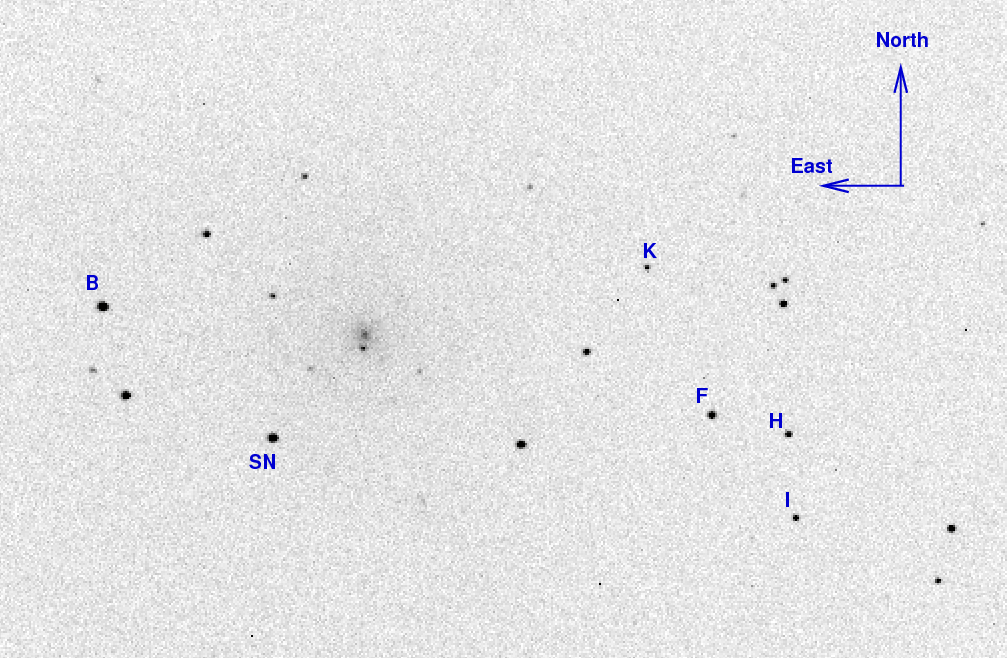
The reference stars marked above have magnitudes in AAVSO chart 12459CA, as follows:
letter B sigB V sigV R sigR I sigI B 13.012 0.019 12.510 0.019 12.154 0.019 11.834 0.019 F 13.848 0.026 13.065 0.022 12.622 0.025 12.152 0.027 H 14.338 0.029 13.692 0.024 13.329 0.029 12.964 0.030 I 14.832 0.027 13.912 0.023 13.416 0.026 12.939 0.030 K 15.192 0.034 14.613 0.027 14.275 0.034 13.915 0.036
I took 30-second unguided images -- the sky was so bright that I couldn't hold the guide star reliably. After discarding the bad images, I was left with 12, 6, 6, and 7 images in B, V, R, and I, respectively.
Using aperture photometry with a radius of 4 pixels (radius of 7.4 arcsec), I measured the instrumental magnitudes of a number of reference stars and the target. Following the procedures outlined by Kent Honeycutt's article on inhomogeneous ensemble photometry, I used all stars available in each image to define a reference frame, and measured each star against this frame. I used the AAVSO magnitudes, plus color terms to convert the ensemble instrumental magnitudes to the standard Johnson-Cousins BVRI scale.
The transformation from instrumental to Johnson-Cousins magnitude had a larger uncertainty in the B-band than usual. I checked and saw that stars "K and "I", the faintest of the B-band reference stars, were about 0.1 mag away from the other reference stars in zeropoint. I discarded those two from the B-band solution.
Results from this morning are:
filter mag mag_uncert Julian Date B = 13.831 +/- 0.056 (ens 0.046 zp 0.033) 2456528.70689 V = 12.864 +/- 0.038 (ens 0.026 zp 0.027) 2456528.70017 R = 12.470 +/- 0.025 (ens 0.014 zp 0.021) 2456528.69482 I = 12.255 +/- 0.036 (ens 0.021 zp 0.029) 2456528.71430
The uncertainties here are roughly equally distributed between extracting the instrumental magnitudes and transforming the instrumental magnitudes to the standard scale.
Grab the text file below for all the RIT measurements of SN 2013ej. All these values have been recomputed with the new color terms of UT 2013 Aug 05.
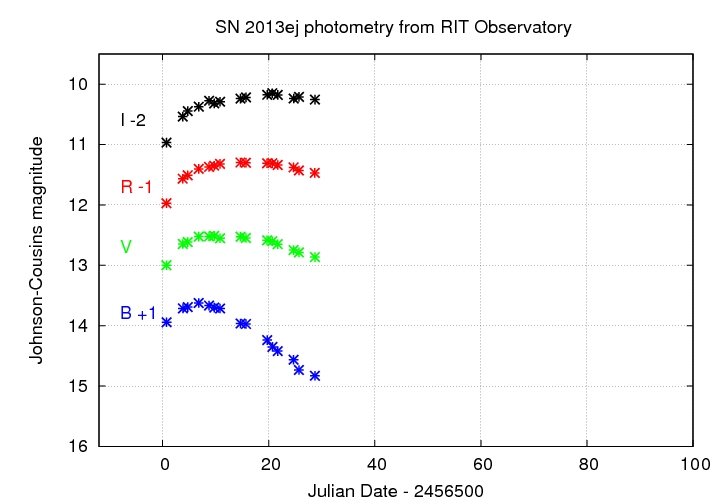
Last modified 08/20/2013 by MWR.